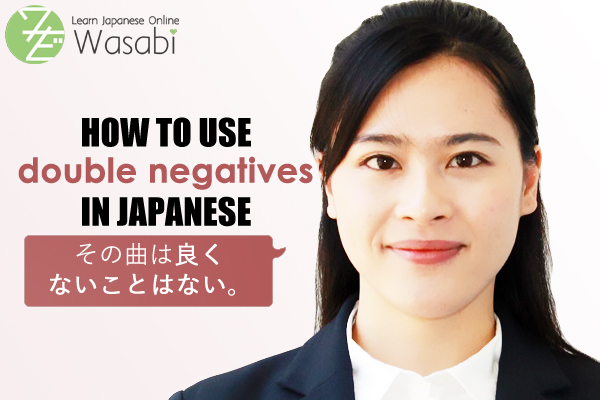How to use Double Negatives in Japanese
Welcome back to our “Video & Article” series with tutor Miki. In this article and video we will take a look at expressing positive statements by using double negatives in Japanese. For example: “よくないことはない”. Learn how to express subtle nuances by using double negatives in Japanese!
| Table of Contents [Introduction] [Grammatical Patterns] [Purpose of the Double Negative] |
[Introduction]
In today’s lesson we will take a look at using a double negative statement to express a positive statement. This is usually done to soften the statement or to convey subtle nuances or vagueness. First of all, we will take a look at how to form double negative statements grammatically. Then we will move on to a couple of examples. While the art of using two negatives to make a positive statement can also be utilised in English (“This isn’t not good!”), it seems to be a lot more common in Japanese.
[adsense]
[Grammatical Patterns]
The double negative is called “二重否定” in Japanese. Let’s take a look at two patterns used to express a double negative in Japanese:
1) ~なくはない
2) ~ないことはない
The two uses of a grammatical negative cancel each other out, ultimately forming a positive statement.
ない+ない=ある
Let’s look at some examples:
その曲は良くないことはない。
Literal: This song is not not good.
Meaning: This song isn’t bad.
弱音を吐かなくはない。
Literal: I don’t don’t whine.
Meaning: I do whine.
This is the general grammatical structure for “なくはない”:
(弱音を)吐か(なくはない)
(direct object)(double negative)
It’s not that I don’t whine.
Before the double negative “なくはない” you can only use i-adjectives and non-volitional, including the potential form. For the conjugation you replace the “い” of the negative ending “ない” with “く” and the connect it with “はない”: “なくはない”.
To make a grammatically correct sentence with “ないことはない” you simply connect the negative form of the preceding verb or adjective with the nominalizer “こと” and then add “はない”.
その曲は良くないことはない。
(subject/topic) (double negative)
It’s not that the song is not good.
Lastly, let’s look at one more example before we move on:
その営業成績もよくないこともない。
The results for that business weren’t not good.
In other words this means:
その成績は良かった。
The results were good.
[Purpose of the Double Negative]
So why do people choose to use the double negative form instead of directly saying what they want to say? There are three situations in which you can make use of the double negative.
1) When you generally agree with a statement but something doesn’t feel right, and you want to softly convey this.
Look at this example:
A: これ可愛いから欲しいなぁ。
A: I want this because it’s cute.
B: これはどう?
B: What about this one?
A: うーん、これは可愛くない訳ではないけれど、なんか探してたものと違うんだよなぁ。
A: Hm, it’s not like that one isn’t cute, but it’s not quite what I was looking for.
Here, using the double negative form allows speaker A to avoid directly contradicting the statement of speaker B. You can use the double negative like this to prevent hurting a friend.
Let’s move on!
2) You can use double negative for poetry or meaningful statements
This may not be very useful for daily conversations, but important to know. To express the meaning of something, double negative is often used in poetry or song lyrics. For example:
無きにしも非ず
Not completely lacking, a little (existent)
This phrase is used for stating that it is “certainly possible” something might happen, maybe even against all odds:
勝利の希望も無きにしも非ずだ。
We are not entirely without the hope of winning.
3) You can use double negative when you intentionally want to make your sentence vague
A child for example may use this grammar pattern to avoid answering a question from their parents clearly:
A: 宿題やった?
A: Did you do your homework?
B: 宿題やってないわけではない。
B: It’s not that I didn’t do my homework.
However, since this is a very specific grammar pattern, overusing it may dilute the subtle nuance you want to give your statement. Additionally, using this once or twice works since the actual meaning can be easily be deducted. However, overusing this pattern can lead to nonsense since entire paragraphs might become too vague for listeners to understand your point (so avoid doing this unless that is your intention).
Even when using double negative, make sure to pay attention to the purpose and clarity of your sentences.
In an argument, for example, you can make your intention of politely disagreeing sure and then use the double negative form:
賛成できないわけではないけど、-のため、反対です。
It’s not that I cannot agree, but because of X Y and Z, I have to disagree with you.
In this case, this may be similar to the English “I see your point, but”, or “I see where you’re coming from, but”.
That is everything for today’s lesson. We hope that this helps you understand and utilize double negative sentences in Japanese. If you would like to learn more about this topic, feel free to book a lesson with one of our native, qualified Japanese tutors anytime!
| 二重否定 | Double negative |
| 重ねる | To pile up, to add, to repeat |
| 表現方法 | Way of expressing something |
| 曖昧 | Vague, ambiguous |
| 曖昧な言い方 | Vague way of talking |
| 曖昧さ | Ambiguity |
| 強調 | Emphasis |
| 物事 | Things, everything |
| 場面 | Setting, scene |
| 肯定 | Positive |
| 弱音を吐く | To whine |
| 営業 | Business, trade |
| 成績 | Results, grades |
| 賛成 | Approval, agreement |
| 賛成する | To approve, to agree |





